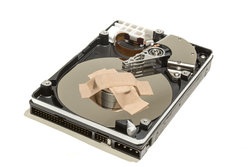Duct Tape and Band-Aids: Today's Credit Union Core Processors
 In an article entitled "Core Banking Systems: The Industry’s Achilles Heel," The Financial Brand sheds light on the dismal state of our nation's financial system core technology. A large number of core systems "have been nursed along for decades with little more than band-aids, duct tape, and some chicken wire". Soon, there will be so much repair work, outdated core processors may as well be in full body casts. That being said, why are so many executives reluctant to undergo a core conversion and make the changes they know they need?
In an article entitled "Core Banking Systems: The Industry’s Achilles Heel," The Financial Brand sheds light on the dismal state of our nation's financial system core technology. A large number of core systems "have been nursed along for decades with little more than band-aids, duct tape, and some chicken wire". Soon, there will be so much repair work, outdated core processors may as well be in full body casts. That being said, why are so many executives reluctant to undergo a core conversion and make the changes they know they need?
To help answer that question, NTT Data Consulting conducted a study that uncovered 70% of financial institution executives are frustrated with their core systems, and 100% of all respondents could pinpoint at least one major challenge their core presents to running their organization efficiently. However, only 10% are actually looking to make a core system change in the next year.
With technology, there is always a fear that what you are buying today will be obsolete tomorrow. If not obsolete, at least much less expensive. Think about the astronomical price of flat screen TVs when they were first released on the market, compared to the latest Amazon Prime Deal of the Day. Taking that a step further, think about how much good that VCR is doing for you in your attic. There is no amount of band-aids or duct tape to make that old VCR play Blu-Ray DVDs or stream Netflix over your home network.
In the aforementioned study, it was found that 78% of respondent's IT budgets were spent simply on maintaining their legacy core deposit systems. It is difficult to see beyond a processor you have already poured so many resources into, knowing there is more time and money involved in undergoing a core system review and eventually a credit union core conversion. So financial institutions turn to quick-fixes, adding services that their members are demanding through a hodge-podge of various vendor applications.
Rubber-banding a DVD player to the VCR will not bring it up to date, much like continually bolting on third party applications to an already struggling core solution will not modernize your infrastructure. In fact, depending on the technology and how the application interacts with your credit union's current software, it could worsen your already struggling state.
With all the resources that credit unions are pouring into antiquated systems, the question is again turned to the reasons why so much reluctance exists to switch credit union core processors? Are executives concerned that once they sign with a new core, prices will increase drastically, or are they more concerned about the cost and time required to complete a successful core system conversion? Just as it is critical for credit unions to stop using tools from the stone age to survive in the digital age, it is equally important they work with a core provider they trust, that stands behind their commitment to technology and can provide the necessary project planning and training to ensure a smooth transition. Finding that trust can help eliminate the fears of making the big, but necessary, change.



